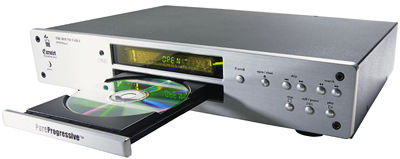Camelot Technology Round Table DVD player Page 2

Sound Features
Camelot designed the Round Table with the audiophile in mind. It includes DSP digital audio upsampling, which converts a 44.1kHz bitstream, the standard CD format, to 48kHz or 96kHz. The upsampled 16-bit stream is then interpolated to 24 bits via a software-based algorithm that includes a sophisticated dithering function. So in addition to a Dolby Digital/DTS coaxial output, there is a second coaxial digital jack from which you can output the results of the upsampling function. Most likely you'll listen to music through the RT's analog outputs, as the upsampled digital data are converted to analog using the player's high-quality 24-bit/96kHz Burr-Brown DACs (though you could try your receiver's DACs, if they are also rated at 24-bit/96kHz). If you don't want to use the upsampling feature, you can disable it with the flick of a switch and output the source's resolution of 16/44.1, unaltered, from the player's digital or analog outputs.
But what if you're a fan of Pacific Microsonics' HDCD and you want to play it back correctly? The Round Table has something for you: Flip another switch and you disable the upsampling circuitry and enable the HDCD decoding chip. Play an HDCD and a front-panel light lets you know it's being decoded correctly. To hear HDCD, you'll have to use the analog outputs—unless your receiver or surround processor includes an HDCD decoder, in which case you have a redundant feature. The RT also includes a TosLink optical and an I2S digital output. I2S is a sophisticated low-jitter, sound-enhancing connection that separates the sonic bitstream from the control information (track number, track length, time remaining, etc.). It's compatible only with 24/96 DACs and, of course, with processors that include an I2S bus input jack.

Performance
I had the $11,500 Ayre D-1 and the Round Table in-house at the same time, and spent a lot of time comparing their audio and video performances. Both use the DVDO chip, and both offered the same superb, filmlike DVD performance, although—either because my mind played tricks with me or because of the Ayre's insanely meticulous design—the Ayre seemed to look more creamy, quiet, and pure than the Camelot. But the differences weren't huge. When the Ayre had left the building, the RT never disappointed, yielding superb, filmlike progressive-scan images on my Philips 55-inch widescreen set, which can project a 480p signal. I was never conscious of any artifacts or jaggies, even during the most complex motion sequences. I was disappointed when I switched back to my non-progressive-scan Pioneer DV-05, even though the Pioneer is a wonderful player and the Philips has a very good built-in line doubler. The Camelot handled film and video transfers with equal aplomb.
I found the Round Table's overall clarity, focus, detail, edge definition, color saturation, and balance to be superb, but thought the Ayre's overall video performance was slightly more 3-dimensional and transparently pure. But it was close. Using patterns from the Avia and Video Essentials test DVDs, I found the resolution (500 horizontal lines), bandwidth, freedom from motion artifacts, and the other specs easily measurable by a lay person, to be just about perfect. I know that measurements don't tell the whole story in audio, and perhaps the same is true with video. In any case, the RT's picture quality was superb. I wished I had a much less expensive progressive-scan player on hand to compare it with, but I didn't.
- Log in or register to post comments













































